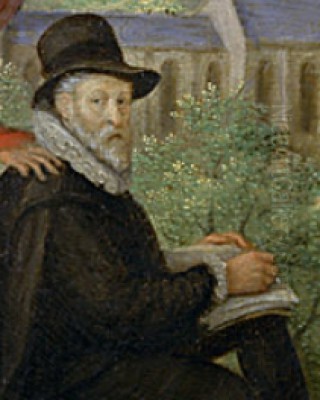
Lucas van Valckenborch the Elder stands as a significant figure in the rich tapestry of Flemish Renaissance painting. Active during the latter half of the sixteenth century (circa 1535–1597), he navigated a period marked by profound religious upheaval and political instability, experiences that deeply shaped both his life and his art. Primarily celebrated for his evocative landscapes, Valckenborch also excelled in portraiture, allegorical scenes, and depictions of bustling market life. His work forms a crucial link in the development of landscape painting, building upon the innovations of his predecessors while forging a distinct path that reflected both keen observation and imaginative power. Belonging to a prolific artistic dynasty, his influence extended through his family and his engagement with the major artistic centers of his time, from Mechelen and Antwerp to Linz and Frankfurt.
Origins and Early Career in Mechelen
The precise birthplace of Lucas van Valckenborch remains a subject of scholarly discussion, with both Leuven and possibly Liège cited as potential locations around the year 1535. What is more certain is his early artistic formation, which likely took place in Mechelen, an important artistic center in the Southern Netherlands at the time. Records indicate that he was registered as a master painter in the Mechelen Guild of Saint Luke by 1560. This suggests he had completed his apprenticeship and demonstrated the requisite skill to practice independently.
Mechelen provided a fertile ground for young artists. While the identity of his specific master is not definitively documented, the artistic environment was heavily influenced by the burgeoning tradition of landscape painting. Artists like Herri met de Bles, active slightly earlier, had already established fantastical, panoramic landscapes as a popular genre. It is highly probable that Valckenborch absorbed these local traditions during his formative years.
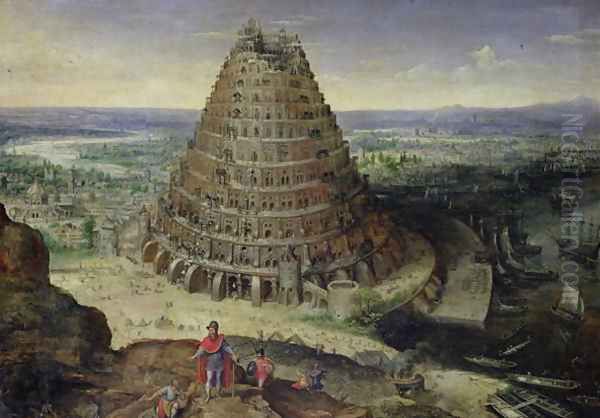
Furthermore, Mechelen was where he likely encountered the powerful influence of Pieter Bruegel the Elder, arguably the most innovative Flemish painter of the era. Although direct tutelage is not proven, the stylistic and thematic parallels between their works, particularly in landscape composition and the depiction of peasant life, are undeniable. Valckenborch's early works likely began to show the hallmarks of this influence, blending detailed observation with a broad, encompassing view of the world. His brother, Marten van Valckenborch the Elder, also trained as a painter, likely alongside Lucas, beginning a lifelong artistic connection.
Religious Turmoil and Years of Migration
The mid-sixteenth century in the Low Countries was a period of intense religious conflict between Catholics and burgeoning Protestant groups, primarily Calvinists. This tension culminated in the Beeldenstorm, or Iconoclastic Fury, of 1566, where Protestant mobs destroyed religious images in Catholic churches across the region. This event, and the subsequent harsh crackdown by the Spanish Habsburg rulers under the Duke of Alba, created a dangerous environment for those suspected of Protestant sympathies.
Lucas van Valckenborch, likely holding Protestant beliefs (or at least associated with circles sympathetic to the Reformation), found his position in the Southern Netherlands increasingly precarious. Around 1566, coinciding with the Beeldenstorm, he left Mechelen. Along with his brother Marten and fellow painter Hans Vredeman de Vries, he sought refuge first in Aachen, a city known for its relative tolerance at the time. This move marked the beginning of a peripatetic phase in Valckenborch's life, driven by the need for safety and the search for patronage in more stable environments.
His time in Aachen was followed by a period in Antwerp, the bustling commercial and artistic heart of the Low Countries. Despite the ongoing political tensions, Antwerp remained a major center for art production and trade. Valckenborch likely re-established connections within the city's artistic community. However, the continued conflict of the Eighty Years' War (the Dutch Revolt against Spanish rule) meant that stability was elusive. His movements reflect the broader diaspora of Netherlandish artists, many of whom fled religious persecution and economic hardship, carrying their skills and styles to new regions, particularly within the Holy Roman Empire.
The Enduring Influence of Pieter Bruegel the Elder
The artistic debt Lucas van Valckenborch owed to Pieter Bruegel the Elder (c. 1525-1569) cannot be overstated. While Valckenborch developed his own distinct style, Bruegel's innovations provided a foundational framework, particularly in the realm of landscape and genre painting. Bruegel had revolutionized landscape by moving beyond the purely fantastical elements seen in the work of Joachim Patinir, the pioneer of the "world landscape" (Weltlandschaft), towards compositions that integrated human activity and observation of nature more convincingly.
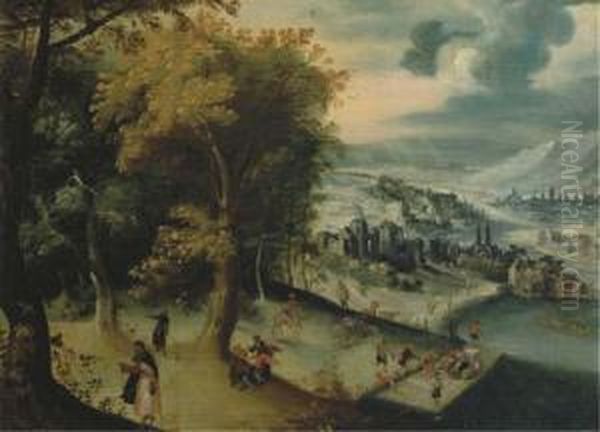
Valckenborch adopted Bruegel's high viewpoint and panoramic scope, creating expansive vistas that often encompassed mountains, rivers, valleys, and distant towns. This approach allowed for a wealth of detail and narrative potential within a single composition. Like Bruegel, Valckenborch often populated his landscapes with small figures engaged in everyday activities – peasants working the fields, travelers on roads, skaters on frozen rivers – grounding the grand scale of nature in human experience.
Furthermore, Bruegel's interest in depicting the labours of the months and the changing seasons found a strong echo in Valckenborch's work. Series depicting seasonal activities became a recurring theme for Valckenborch, allowing him to explore different atmospheric conditions and human responses to the natural cycle. However, where Bruegel's figures often possess a robust, sometimes caricatured earthiness, Valckenborch's figures tend to be more slender and perhaps less individualized, serving more explicitly as elements within the overall landscape composition. His colour palette also sometimes differed, occasionally employing brighter hues compared to Bruegel's more muted tones.
Court Painter in Linz: Service to Archduke Matthias
A significant chapter in Valckenborch's career began around 1579-1580 when he entered the service of Archduke Matthias of Austria (later Holy Roman Emperor). Matthias had briefly served as Governor-General of the Habsburg Netherlands in Brussels, attempting to mediate the complex political situation. Valckenborch became his court painter during this period. When Matthias relinquished his governorship and relocated to Linz, Austria, Valckenborch accompanied him, remaining in his service for roughly a decade.
This appointment provided Valckenborch with financial stability and prestige. As a court painter, his duties likely included painting portraits of the Archduke and his circle, as well as creating works to adorn the ducal residences. His time in Linz was particularly productive for landscape painting. It was during this period that he created several series depicting the months or seasons, often set within identifiable or imagined Austrian landscapes, blending topographical observation with allegorical meaning.
Working for Matthias placed Valckenborch in a milieu that included other artists and intellectuals. Joris Hoefnagel, another prominent Flemish artist known for his miniatures and topographical views, was also associated with the Habsburg courts around this time, and their paths may well have crossed, sharing a common Netherlandish heritage and interest in detailed observation. Valckenborch's portraits from this period, such as those of Matthias himself, demonstrate his competence in capturing likeness while adhering to the conventions of court portraiture. This patronage was crucial, allowing him to refine his skills and produce ambitious works.
The Valckenborch Landscape: Style and Motifs
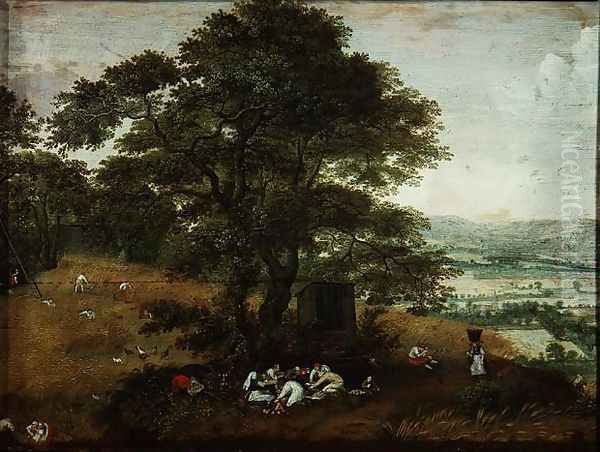
Lucas van Valckenborch is best remembered as a master of landscape. His signature style evolved from the Bruegelian model but incorporated his own sensibilities and observations. He excelled at rendering dramatic, often fantastical rock formations, towering cliffs, and deep, winding river valleys. These elements, while perhaps exaggerated for artistic effect, convey a powerful sense of nature's grandeur, a hallmark of the Northern Renaissance landscape tradition stretching back to Patinir and Herri met de Bles.
His compositions typically employ the "world landscape" structure: a high vantage point offering a sweeping panoramic view, often divided into distinct foreground, middle ground, and background zones. These zones are frequently differentiated by colour, using warmer browns and greens in the foreground, transitioning to cooler greens and blues in the middle distance, and culminating in hazy, atmospheric blues and violets on the horizon. This aerial perspective creates a convincing illusion of depth and vastness.
Valckenborch paid meticulous attention to detail. Trees are rendered with attention to foliage types, buildings are often depicted with architectural accuracy (even when placed in imagined settings), and human figures, though small, are clearly delineated in their activities. He was particularly adept at capturing atmospheric effects – the crisp air of winter, the haze of summer, the play of light on water and rock. Works like View of Antwerp with the Frozen Scheldt (1593) showcase his ability to combine topographical accuracy with lively genre detail, depicting citizens enjoying the ice.
Depicting Life: Market Scenes and Allegories
Beyond pure landscape, Valckenborch made significant contributions to genre painting, particularly through his depictions of market scenes and allegorical representations of the seasons or labours. His market scenes, often large-scale works, provide vivid snapshots of sixteenth-century economic and social life. Paintings like the Meat Market or Fish Market (often part of seasonal series) bustle with activity, showing vendors displaying their wares, customers inspecting goods, and the general hubbub of commerce.
These scenes were more than simple documentation; they often carried allegorical or moralizing undertones, reflecting contemporary attitudes towards abundance, consumption, and the rhythms of life. His series depicting the Four Seasons or the Labours of the Months allowed him to combine landscape painting with genre elements, illustrating how human life was intimately tied to the natural world and its cycles. Spring Ploughing (1584) or Allegory of Autumn (1595), with its central market theme, exemplify this fusion. The latter, one of nine known large market scenes, is particularly rich in detail, showcasing diverse produce and human interactions.
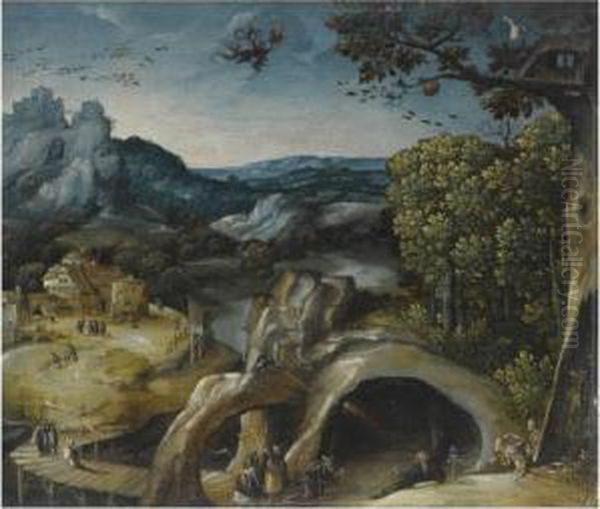
Valckenborch also tackled explicitly allegorical and religious themes, most famously in his multiple versions of the Tower of Babel. Inspired by the biblical story and likely by Bruegel's iconic interpretations, Valckenborch created at least seven known versions of this subject. His depictions often emphasize the immense scale of the doomed construction project, contrasting the hubris of human ambition with the power of the divine. These works showcase his skill in architectural rendering and his ability to manage complex compositions filled with numerous small figures, echoing the influence of Hieronymus Bosch in their intricate detail and fantastical scope.
Collaboration, Workshop, and the Valckenborch Dynasty
Artistic production in the sixteenth century often involved collaboration and workshop assistance, and Lucas van Valckenborch was no exception. His closest collaborator was undoubtedly his brother, Marten van Valckenborch the Elder (1535–1612). Having trained together, they maintained a close relationship throughout their careers, even sharing the experience of exile. While Lucas is generally considered the more prominent landscape specialist, Marten also produced landscapes, along with allegorical and biblical scenes. It is plausible they collaborated on certain works, or at least shared workshop resources and stylistic approaches, particularly during their time together in Antwerp and later in Frankfurt.
Lucas also likely employed assistants or pupils in his workshop, especially during his time as a court painter and later in Frankfurt. One notable artist associated with him is Georg Flegel (1566–1638). While primarily known as a pioneer of German still life painting, Flegel is documented as having worked in Valckenborch's studio, possibly adding still life elements like fruit, vegetables, or flowers to Valckenborch's larger compositions, particularly the market scenes. This collaboration highlights the specialization emerging within artistic workshops.
The Valckenborch family itself constituted a remarkable artistic dynasty. Besides Lucas and Marten, Marten's sons, Gillis van Valckenborch (c. 1570–1622) and Frederik van Valckenborch (c. 1566–1623), also became accomplished painters, carrying the family's artistic traditions into the early seventeenth century. Frederik, in particular, developed a distinctive style of landscape painting, often featuring dramatic lighting and stormy scenes. This familial network underscores the importance of kinship ties in the transmission of artistic knowledge and practice during this period. In total, around fourteen painters are associated with the Valckenborch name.
Frankfurt: Final Years and Continued Activity
Around 1592 or 1593, after his service to Archduke Matthias concluded (Matthias himself moved on to other roles within the Habsburg hierarchy), Lucas van Valckenborch relocated one last time, settling in Frankfurt am Main. Frankfurt, a Free Imperial City, had become a major refuge for Protestant émigrés from the Low Countries, fostering a vibrant community of merchants, artisans, and intellectuals. Many Netherlandish artists found patronage and opportunity there.
Valckenborch acquired citizenship in Frankfurt in 1594, indicating his intention to establish himself permanently. He continued to be artistically active during these final years, producing landscapes, market scenes, and possibly portraits. His presence contributed to Frankfurt's status as an important artistic center, bridging Netherlandish traditions with the developing German art scene. Younger artists active in Frankfurt around or shortly after this time, like Adam Elsheimer, would further develop landscape and genre painting, building on the foundations laid by émigrés like Valckenborch.
His brother Marten also settled in Frankfurt around the same time, and the two likely continued their close association. Lucas passed away in Frankfurt and was buried on February 14, 1597. He left behind a substantial body of work and a reputation as one of the leading landscape painters of his generation. Anecdotal evidence suggests a personal side to the artist; Karel van Mander, the early biographer of Netherlandish painters, noted Valckenborch's fondness for music, mentioning his skill with the fife and enjoyment of playing with his family, adding a touch of warmth to the image of this industrious artist.
Legacy and Position in Art History
Lucas van Valckenborch occupies a vital position in the history of Northern European art, particularly in the evolution of landscape painting. He successfully absorbed the groundbreaking innovations of Pieter Bruegel the Elder, adapting the "world landscape" formula and the focus on peasant life and seasonal cycles to his own artistic temperament. His work is characterized by its detailed execution, panoramic scope, and often dramatic rendering of natural features, especially rock formations.
He played a crucial role in disseminating the Bruegelian landscape style beyond the Low Countries, particularly into Austria and Germany, through his travels and his prestigious position as a court painter. His numerous depictions of the Tower of Babel, the seasons, and market scenes contributed significantly to the popularity of these themes. His detailed market scenes offer invaluable visual documentation of the era's commerce and daily life, standing alongside similar works by contemporaries like Pieter Aertsen and Joachim Beuckelaer, though Valckenborch integrated these genre elements more fully into expansive landscapes.
As a member of a prolific artistic family, he contributed to a legacy that extended into the next generation. His influence can be seen in the work of his brother Marten and his nephews Frederik and Gillis. Furthermore, his style provided a bridge between the High Renaissance landscape tradition of Bruegel and the subsequent developments in Flemish and Dutch landscape painting in the early seventeenth century, exemplified by artists such as Jan Brueghel the Elder (Pieter Bruegel's son), Gillis van Coninxloo (another Flemish émigré known for forest scenes), Esaias van de Velde, and Pieter Stevens. Valckenborch's meticulous technique and his ability to blend realism with imaginative composition ensured his enduring reputation.
Conclusion
Lucas van Valckenborch the Elder was more than just a follower of Bruegel; he was a distinct and influential artistic voice in his own right. Living through a tumultuous era, his life was marked by displacement and adaptation, yet his artistic output remained consistently high in quality and innovation. As a master of the panoramic landscape, a keen observer of daily life in his market scenes, and an interpreter of allegorical and biblical narratives, he created a diverse and compelling body of work. His paintings offer a window onto the natural world and human society of the late sixteenth century, rendered with remarkable detail and atmospheric sensitivity. His role as a court painter, his collaborations, and his position within a significant artistic dynasty further solidify his importance, securing his place as a key figure in the rich tradition of Flemish Renaissance art.